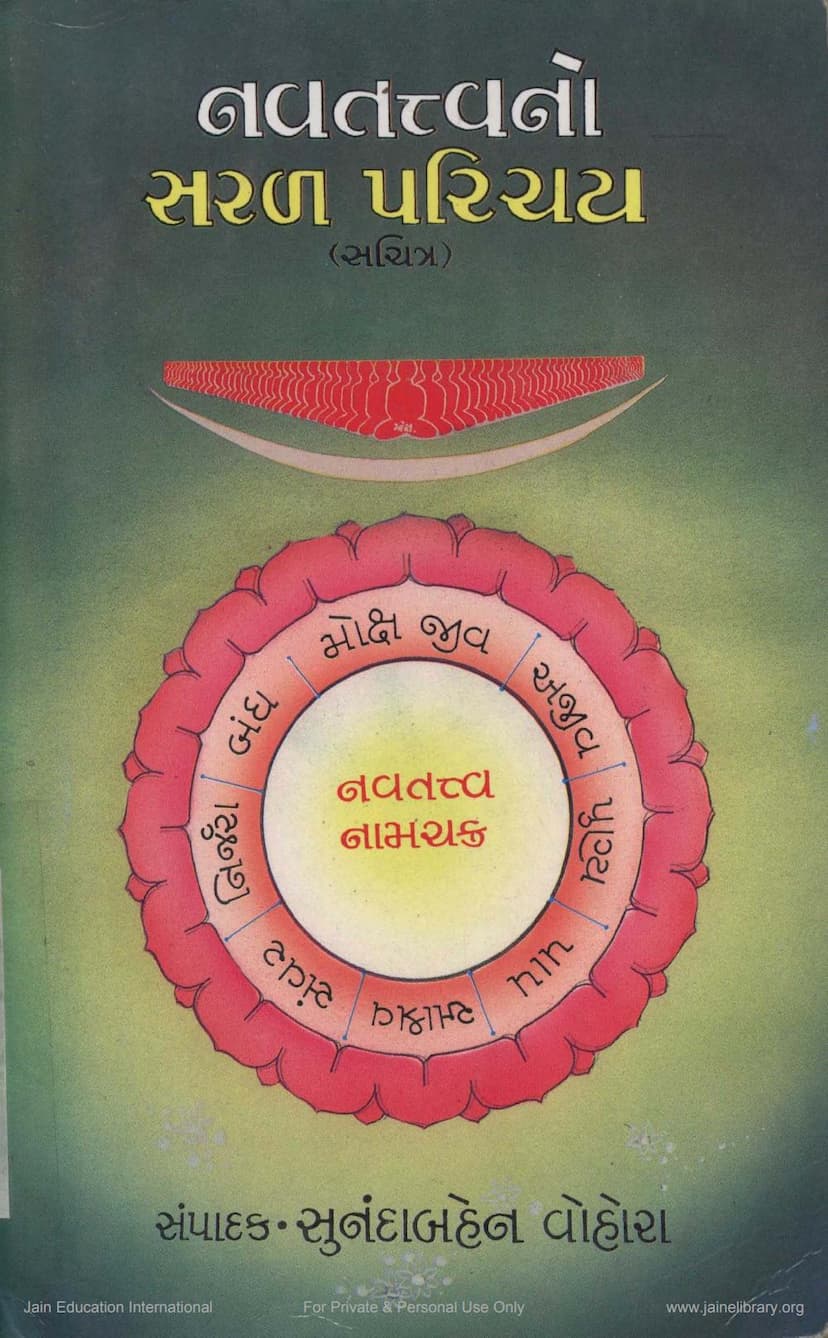Navtattvano Saral Parichay
Added to library: September 2, 2025

Summary
Here's a comprehensive summary of the Jain text "Navtattvano Saral Parichay" (A Simple Introduction to the Nine Tattvas) by Sunandaben Vohra, based on the provided pages:
Book Overview:
"Navtattvano Saral Parichay" is a Jain text designed to provide a simple and accessible introduction to the fundamental principles of Jainism, known as the Navtattvas (Nine Tattvas). The book is structured into two volumes: a primary, simpler introduction, and a more detailed, expansive explanation. The author, Sunandaben Vohra, aims to make these profound concepts understandable for both new and experienced practitioners. The book is illustrated to aid in comprehension.
Core Philosophy:
The central theme of the book is the understanding and application of the Navtattvas as the path to liberation (Moksha) and true happiness. The author emphasizes that the true purpose of life is to realize the soul's pure nature, free from the bondage of karma. The book aims to inspire faith and guide individuals towards this ultimate goal.
The Nine Tattvas (Navtattvas):
The book systematically introduces and explains each of the nine essential categories in Jainism:
- Jiva Tattva (Soul/Living Being): The soul is the essence of consciousness, inherently pure, blissful, and possessing infinite knowledge and power. In its current state, due to karma, it experiences birth, death, and suffering. The book elaborates on the various classifications of Jivas (souls) based on senses, lifespan, and other characteristics.
- Ajiva Tattva (Non-Soul/Inert Matter): This encompasses everything that is not a soul. It is insentient, without consciousness, and does not experience pleasure or pain. The Ajiva category is further divided into five sub-categories:
- Dharmastikaya: The principle that aids in motion.
- Adharmastikaya: The principle that aids in rest or stillness.
- Akashastikaya: Space, which provides accommodation for all substances.
- Pudgalastikaya: Matter, which has form, touch, taste, smell, and color. This is the only tangible substance.
- Kala (Time): The subtle force that brings about change.
- Punya Tattva (Merit/Virtue): This refers to the karmic consequences of good deeds, virtuous actions, and positive intentions, which lead to happiness and favorable circumstances in life. It is considered a means to attain worldly pleasures and can serve as a stepping stone towards spiritual progress.
- Papa Tattva (Demerit/Sin): This refers to the karmic consequences of negative actions, harmful intentions, and unwholesome states of mind, which lead to suffering and unfavorable circumstances. It is the cause of bondage and further cycles of rebirth.
- Asrava Tattva (Influx of Karma): This describes the channels through which karmic particles attach to the soul. It is caused by sensory indulgence, passions (kashayas), and various activities of mind, speech, and body, fueled by ignorance (mithyatva) and vows (avrati).
- Samvara Tattva (Stoppage of Karma): This is the process of blocking the influx of new karmic particles. It is achieved through self-control, adherence to vows, practice of virtues, contemplation, and control over senses and mind.
- Nirjara Tattva (Shedding of Karma): This is the process of eradicating the accumulated karmas from the soul. It is achieved through austerities (tapas), penance, and the practice of right conduct. Nirjara can be involuntary (akama) or voluntary (sakama).
- Bandha Tattva (Bondage of Karma): This is the state where karmic particles are bound to the soul, obscuring its inherent pure qualities. The book explains the nature of karma, its eight primary types (Jnanavaraniya, Darshanavaraniya, Vedaniya, Mohaniya, Ayushya, Nama, Gotra, Antaraya), and how they affect the soul.
- Moksha Tattva (Liberation): This is the ultimate goal, the state of complete freedom from all karmic bondage. It is the realization of the soul's true, pure, and eternal nature, characterized by infinite knowledge, perception, bliss, and power.
Key Concepts and Themes:
- Two Divisions: The book is divided into two sections, the first offering a simpler overview and the second a more detailed exploration, facilitating gradual learning.
- Importance of Faith: The text stresses that true understanding and practice are rooted in firm faith (shraddha) in the teachings of the omniscient beings (Jinas) and the principles of the Navtattvas.
- Path to Happiness: The book presents the Navtattvas as the practical path to overcoming suffering and achieving eternal bliss, emphasizing that true happiness lies in self-realization, not in external possessions or worldly pleasures.
- Karma Theory: A significant portion of the book is dedicated to explaining the intricate workings of karma, its causes, effects, and classifications, highlighting how it binds the soul and necessitates spiritual practice.
- Virtues and Practices: Various Jain practices, virtues, and disciplines like fasting, vows, meditation, study, and service are explained in relation to their role in achieving Samvara and Nirjara.
- Distinction between Punya and Moksha: While Punya (merit) is acknowledged as a cause of temporary happiness and favorable circumstances, it is clearly distinguished from Moksha, which is the eternal liberation achieved through the destruction of all karma.
- The Role of the Soul: The book consistently emphasizes the soul (Jiva) as the central focus of spiritual endeavor, urging readers to understand its true nature and strive for its liberation.
- Illustrations: The book is enriched with illustrations to visually represent concepts like the Jivas, senses, and the progression through spiritual stages.
Author's Intent:
Sunandaben Vohra's aim is to demystify the complex Jain philosophy of the Navtattvas, making it accessible and inspiring for a wider audience. The book reflects her deep devotion and commitment to sharing this knowledge, as evidenced by the multiple editions and the effort to make it available in different locations.
Overall Purpose:
"Navtattvano Saral Parichay" serves as a foundational text for understanding the core tenets of Jainism. By elucidating the Navtattvas, it provides a roadmap for spiritual growth, emphasizing the importance of knowledge, faith, and right conduct in achieving the ultimate goal of Moksha.